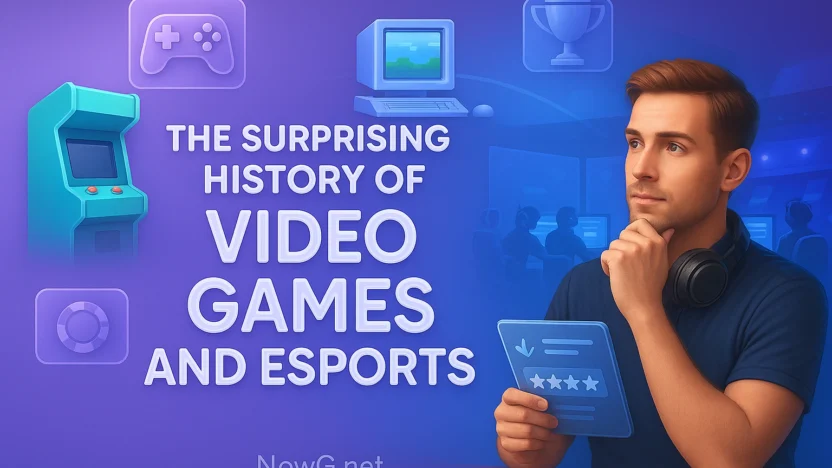Esports didn’t start with Twitch, stadium LEDs, or seven-figure prize pools. The roots go back to lab basements, coin-op arcades, and living rooms where high scores were bragging rights long before they were media products. That’s the surprise: competitive gaming evolved in waves—grassroots first, then organized circuits, and only much later the polished, publisher-run ecosystems we now treat as inevitable.
The arc is messy, cyclical, and honestly… instructive.
From Coin-Ops to Campus Labs: Competition Before “Esports”
If you’ve ever chased a leaderboard in an arcade, you’ve played the primitive version of esports. Local operators ran informal contests; magazines published national scoreboards; university labs hosted early tournaments on mainframes and early PCs. No sponsorship decks. No broadcast trucks. Just reputation and community.
What still fascinates me is how quickly skill communities formed around specific titles. Arcades were matchmaking hubs without the internet. Scores were public, rivalries were local, and the “meta” spread by rumor, not patch notes. It was noisy and imperfect and yet, it worked.
We romanticize it now, but the DNA—optimize, iterate, compete—was already there.
The LAN Era: Where Culture Outran Infrastructure
Home PCs and local networks created something magical: LAN parties.
Skill density spiked because players finally faced each other with low latency. Strategies matured overnight. I remember watching teams draft roles and coordinate utilities as if they’d trained together for months—because in a sense they had, just not formally. LANs taught two vital lessons: coordination scales skill, and spectatorship is social. People would gather around a single CRT like it was a ringside seat.
The irony? LAN culture grew faster than the infrastructure to monetize it. Venue costs, travel, inconsistent formats—everything was duct tape and goodwill. But it built the player base and the expectations that later organizers would professionalize.
Korea’s Broadcast Revolution: Esports Learns TV
When broadband and PC cafés converged in certain markets, especially in East Asia, the game changed. Teams had sponsors, players had celebrity, and TV stations learned how to shoot 1v1 and 5v5 with narrative arcs, production value, and pacing that regular sports viewers could parse. This wasn’t just “people playing games”; it was a programmable product with appointment viewing. The ripple effect was enormous: standardized formats, consistent schedules, and—quietly—the emergence of player development systems.
It’s easy to underestimate how decisive that broadcast step was. Once you can schedule and sell inventory, you can build seasonality. Once you have seasonality, you can build habit. Habits are the bedrock of media businesses.
Livestreaming: The Day the Walls Fell
Livestreaming annihilated scarcity. Tournament broadcasts could reach global audiences without gatekeepers, and individual players became their own channels. That changed incentives. A mid-tier pro could secure a living via subs, sponsors, and donations while still competing. Publishers noticed. Some leaned into community-driven circuits; others centralized and built official leagues. Either way, streaming created an always-on layer that classic sports never had.
Here’s the kicker: livestreaming didn’t just expand the audience; it rewired discovery. A new game can “go competitive” within months because distribution is instant, and skill footage is abundant. That’s thrilling for players and brutal for organizers who need calendars, venues, and cash flow.
The Publisher Era: Owning the Sport You Invented
Traditional sports are governed by federations. Esports are governed by intellectual property. Publishers own the rules, the brand, the balance patches, and the commercial rights. That’s not a critique; it’s the structure. When a publisher says, “This is the official league,” that’s the league. The upside is coherence—better scheduling, anti-cheat initiatives, player safety policies, and production consistency. The downside is fragility—if a publisher sunsets a title or shifts strategy, an entire ecosystem can wither.
Have you considered the downstream implications of patch cadence on competitive integrity? Too many balance changes and you invalidate practice; too few and the meta calcifies. Publishers walk that tightrope every season.
Prize Pools, Revenue Reality, and the Sustainability Gap
Let’s face it: giant prize pools draw headlines; sustainable revenue pays the bills. Historically, esports leaned on sponsors first, then media rights, then ticketing/merch. Some titles layered revenue sharing. A few chased franchise models. The reality is nuanced. Audiences are young and global (great for growth), but fragmentation by title and region complicates sales. Seasons can be long; calendars collide; production costs are non-trivial.
What endures? Leagues that treat teams and players like partners, not inventory. Structures that prioritize predictable calendars, cost control, and authentic community integration. Flashy numbers might hook you; healthy unit economics keep you.
Integrity Grows Up: Anti-Cheat, Match-Fixing, and Player Welfare
Any competitive system with money and status at stake attracts risk. Cheating technology improves; so do detection models. You fight match-fixing with data, education, and real consequences; you fight doping with policy and testing; you fight burnout with realistic schedules and formal downtime. “Compliance—the thing no one loves but everyone needs to master.” That line lands because it’s true. The last few years have been a step change in how teams and leagues treat player health, mental coaching, and career longevity. Not perfect, but better.
Regional Realities: Esports Is Not One Market
The most common strategic error I see is treating esports as a single monolith. It isn’t. Platform preferences differ (PC vs. console vs. mobile), payment rails vary, broadcast partners change by territory, and school pipelines range from nascent to mature. Mobile esports can outdraw PC in parts of Asia and LATAM; collegiate frameworks are stronger in North America; community-led LAN circuits still anchor parts of Europe. If your plan isn’t regionalized, it’s probably wrong.
Surprise #1: Casual Culture Built the Pro Scene (Not the Other Way Around)
Pro play didn’t create fandom; it harvested it. Casual play—endless hours in cafés, dorms, living rooms—made pros aspirational. That matters when you consider where to invest. Grassroots tournaments, creator programs, local campus leagues, “open” qualifiers—these aren’t charity line items. They’re the top of the funnel. Ignore them and the pyramid collapses.
Surprise #2: Spectatorship Is a Design Feature
Games that thrive competitively aren’t just balanced; they’re legible. Can a newcomer read the action? Can a broadcast director frame the drama? Are patch notes readable to non-experts? It’s frustrating when a brilliant strategy dies on air because the audience can’t see the turning point. The best titles design for clarity—visual language, camera tools, replay kits—because they know the spectator isn’t an afterthought; the spectator is the product.
Surprise #3: Esports Is Cyclical, Not Linear
Titles surge, plateau, reinvent, and sometimes fade. A league loses momentum, then a new format revives it. A patch collapses a meta, then a new patch resurrects strategic depth. If you’re planning with linear assumptions, you’re going to get whiplash. Scenario planning beats straight-line forecasting every time.
Actionable Playbook: How I’d Engage Esports Today
| Who you are | What to do (practical) | Why it works |
|---|---|---|
| Brand entering esports 🧭 | Pilot with creators + one regional event; fund a community cup; require post-event insights deliverable 📊 | You test resonance without overcommitting, gather first-party learning, and build authentic presence—not a one-off logo drop |
| Game studio 🎮 | Design for spectatorship early (observer tools, replay APIs, readable UI) 👀 | Broadcast-friendly games convert casual viewers faster and reduce production friction |
| Team org 🛡️ | Invest in player care: schedule discipline, mental coaching, sleep tracking 😴 | Performance gains are real; sponsor perception improves; careers last longer |
| Tournament operator 🏟️ | Standardize formats and timing; publish rulebooks early; lock tech stack 🔧 | Predictability attracts teams and sponsors; fewer broadcast surprises |
| University/college 🎓 | Build varsity + club tiers; integrate with local TOs; offer coach education 🧑🏫 | Layered pathways increase participation and help identify talent sustainably |
| Non-endemic sponsor 💼 | Tie campaigns to in-game moments and creator POVs; measure lift over weeks, not days 📈 | Esports attention is spiky; longitudinal tracking captures delayed effects |
Timeline Snapshot: Milestones That Actually Moved the Needle
| Era | What shifted (and why it mattered) |
|---|---|
| Early computing & arcades 🕹️ | High-score culture fostered local rivalry; proto-tournaments proved demand for structured play |
| LAN party explosion 💻 | Low-latency play accelerated strategy; in-person community built team discipline and identity |
| Broadcast-era in Asia 📺 | TV production codified formats, storylines, and appointment viewing; advertisers finally “got it” |
| Livestreaming everywhere 📡 | Distribution went direct; players and TOs built audiences without gatekeepers; discovery sped up |
| Publisher-run ecosystems 🏁 | IP owners standardized leagues, anti-cheat, and scheduling; commercial rights became coherent |
| Mobile esports rise 📱 | New geographies and demographics unlocked; lower hardware barriers created massive scale |
| Scholastic pipelines 🎓 | Youth-to-pro pathways professionalized; coaching and sports-science practices took root |
The Tech Backbone: Why Tooling Quietly Dictated Growth
No one falls in love with infrastructure until it fails mid-final. Anti-cheat layers, matchmaking, replay systems, API exposure, ingest pipelines for broadcast—these are the invisible levers that pushed esports from hobbyist streams to network-grade shows. When observer clients matured (multi-camera, instant replay, clean feeds), directors could tell real stories instead of chasing the minimap. When APIs exposed match data, analysts added context in real time. The viewer understood more, cared more, returned more.
And let’s talk patches. Balance updates are product management for a live sport. The cadence shapes practice cycles; the depth shapes skill expression; the communication shapes trust. Patch chaos might spike viewership for a week; patch discipline builds an audience for years.
Why Some Esports Flourish and Others Stall
A great competitive title can still stall if the league structure misfires. Overlong seasons punish players and audiences; fragmented calendars exhaust teams and sponsors; poor timing cannibalizes tent-poles. On the flip side, the “right-sized” ecosystem—clear tiers, sane travel, regional seeding into global finals—feels inevitable once you see it. It isn’t. It’s deliberate.
There’s another quiet killer: over-production. If you polish the soul out of the broadcast—sanitized comms, no player cams, zero behind-the-scenes texture—you lose the intimacy that made esports compelling in the first place. Controlled transparency wins: enough access to feel human, enough professionalism to feel premium.
Platforms, Tools, and Data Hubs I Actually Use
(Links below are official and clean. No links in the article body, per your rules.)
| Platform / Resource | What I use it for |
|---|---|
| Twitch | Live discovery, creator ecosystems, audience behavior |
| YouTube Gaming | VOD reach, evergreen guides, cross-title search patterns |
| Liquipedia | Historical brackets, event formats, roster moves |
| HLTV | Match data, rankings, editorial for FPS ecosystems |
| Esports Earnings | Prize pool context and longitudinal comparisons |
| FACEIT | Competitive ladders, anti-cheat ecosystem, matchmaking |
| Challengermode | Community tournaments, grassroots circuit mapping |
| Battlefy | Bracket ops, registration flows, amateur-to-pro funnels |
| Discord | Team ops, community engagement, real-time updates |
| Steam / Battle.net | Patch cadence tracking and official comms |
What Most People Still Get Wrong
Esports ≠ gaming. Gaming is the ocean; esports is a shipping lane. Not every game needs a pro scene, and forcing one can hurt the core audience. Also, the “esports audience” isn’t a single persona. A strategy fan in Europe, a mobile MOBA fan in Southeast Asia, and a collegiate FPS fan in North America share almost nothing except that they all watch competitive play. If your messaging treats them the same, you’re marketing to a myth.
Another misconception: “Big prize pool = big success.” Sometimes, sure. Often, it’s a sugar high. Long-term health looks more like steady match schedules, a transparent path to pro, and credible player care. That’s not billboard material, but it’s what sustains a scene when the hype cycle cools.
How This History Should Change Your Next Move
If you’re building a game, design the spectator layer on day one. If you’re a brand, earn your place with community and creators before you chase a finals weekend. If you’re a team, treat your players like elite performers with finite batteries. If you’re an organizer, publish formats early, stick to calendars, and give your broadcast team the tools they need to actually tell a story.
I remember when integrating real-time data overlays felt futuristic. Now it’s table stakes. The bar keeps moving. The past doesn’t hand us a script; it hands us a warning: ecosystems thrive on clarity, consistency, and respect for the player-viewer loop. Ignore that, and history will repeat itself—with or without you.
So ask yourself—if you vanished your logo from the next broadcast, would anyone miss the value you actually add?




